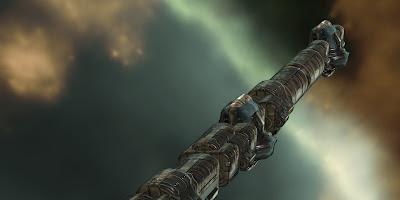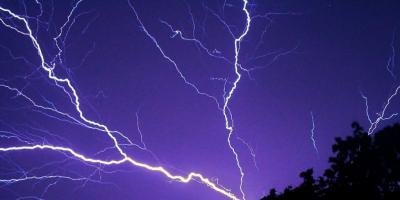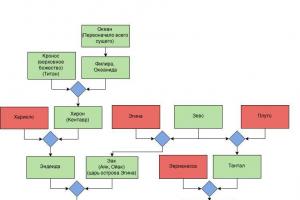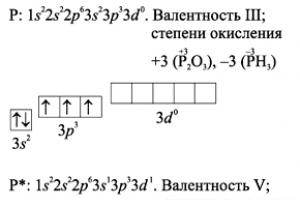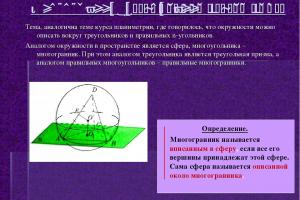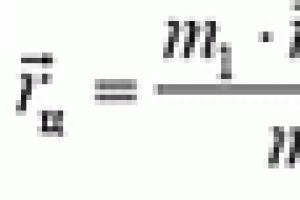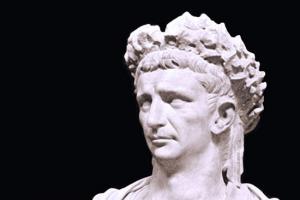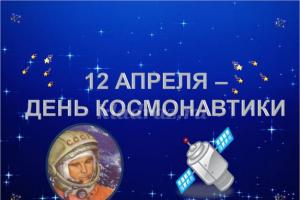Description of the presentation by individual slides:
1 slide
Slide description:
municipal autonomous educational institution secondary school No. 45 Methodological manual for 11th grade students Compiled by a mathematics teacher of the highest category Elena Vyacheslavovna Gavinskaya. Kaliningrad 2016-2017 academic year
2 slide

Slide description:
Polyhedra inscribed in a sphere. The topic is similar to that of the planimetry course, where it was said that circles can be described around triangles and regular n-gons. The analogue of a circle in space is a sphere, and a polygon is a polyhedron. In this case, the analogue of a triangle is a triangular prism, and the analogue of regular polygons is regular polyhedra. Definition. A polyhedron is said to be inscribed in a sphere if all its vertices belong to this sphere. The sphere itself is said to be circumscribed about the polyhedron.
3 slide

Slide description:
“A sphere can be described around a straight prism if and only if a circle can be described around the base of this prism.” Proof: If a sphere is circumscribed around a straight prism, then all the vertices of the base of the prism belong to the sphere and, therefore, to the circle, which is the line of intersection of the sphere and the plane of the base. Conversely, let a circle with a center at point O1 and radius r be described near the base of a straight prism. Then, around the second base of the prism, a circle with the center at point O2 and the same radius can be described. Let O1O2=d, O – the middle of O1O2. Then the sphere with center O and radius R= will be the desired circumscribed sphere. Theorem 1.
4 slide

Slide description:
“A sphere can be described around any triangular pyramid, and only one.” Proof. Let us turn to a proof similar to that from the planimetry course. First of all, we need to find the locus of points equidistant from the two vertices of the triangle. For example, A and B. Such a geometric location is the perpendicular bisector drawn to the segment AB. Then we find the locus of points equidistant from A and C. This is the perpendicular bisector to the segment AC. The intersection point of these bisectoral perpendiculars will be the desired center O of the circle circumscribed about triangle ABC. Theorem 2.
5 slide

Slide description:
Now let's consider the spatial situation and make similar constructions. Let a triangular pyramid DABC be given, and points A, B and C define the plane α. The geometric locus of points equidistant from points A, B and C is a straight line a, perpendicular to the plane α and passing through the center O1 of the circle circumscribed about triangle ABC. The geometric locus of points equidistant from points A and D is the plane β, perpendicular to the segment AD and passing through its vertex - point E. The plane β and straight line a intersect at point O, which will be the desired center of the sphere circumscribed about the triangular pyramid DABC. Indeed, by virtue of the construction, point O is equally distant from all vertices of the DABC pyramid. Moreover, such a point will be unique, since the intersecting straight line and plane have a single common point.
6 slide

Slide description:
A ball circumscribed about a regular pyramid. The ball can be described around any regular pyramid. The center of the ball lies on a straight line passing through the height of the pyramid and coincides with the center of a circle circumscribed about an isosceles triangle, the side of which is the lateral edge of the pyramid, and the height is the height of the pyramid. The radius of the ball is equal to the radius of this circle. The radius of the ball R, the height of the pyramid H and the radius of the circle r described near the base of the pyramid are related by the relation: R2=(H-R)2+r2 This relation is also valid in the case when H< R.
7 slide

Slide description:
The problem is about a ball circumscribed about a regular pyramid. “A sphere with a center at point O and a radius of 9√3 m is described near the regular pyramid PABC. The straight line PO, containing the height of the pyramid, intersects the base of the pyramid at point H so that PH:OH = 2:1. Find the volume of the pyramid if each of its side edges forms an angle of 45 degrees with the plane of the base.”
8 slide

Slide description:
Given: PABC – regular pyramid; the ball (O;R=9√3 m) is described near the pyramid; RO∩(ABC)=N; PH:OH=2:1; ∟RAN=∟ RVN=∟ RSN=45o. Find: Vpir. Solution: Since RN:OH=2:1 (by condition), then RN:OR=2:3 RN:9√3 =2:3 RN=6√3 (m) 2. RN _ (ABC) (as height of the pyramid) => => RN _ AN (by definition) => RAS - rectangular. 3. AT RAS:
Slide 9

Slide description:
4. Since by condition RABC is a regular pyramid and PH is its height, then by definition ABC is correct; H is the center of a circle circumscribed about ABC, which means 5. Answer: 486 m3.
10 slide

Slide description:
A sphere circumscribed around a prism. A sphere can be described around a prism if it is straight and its bases are polygons inscribed in a circle. The center of the ball lies at the midpoint of the height of the prism connecting the centers of the circles described around the bases of the prism. The radius of the ball R, the height of the prism H and the radius of the circle r described around the base of the prism are related by the relation:
11 slide

Slide description:
The problem is about a sphere circumscribed around a prism. “A regular prism ABCDA1B1C1D1 with a height of 6 cm is inscribed in a sphere (so; R = 5 cm). Find the cross-sectional area of the prism by a plane parallel to the planes of the base and passing through point O - the center of the ball.”
12 slide

Slide description:
Given: ABCDA1B1C1D1 – regular prism; a ball (O;R=5 cm) is described around a prism; the height of the prism h is 6 cm; α║(ABC); O with α. Find: Ssec α, Solution: Since, by condition, the prism is inscribed in a ball, then (r is the radius of the circle circumscribed around the base of the prism) But by condition, a regular prism is given, which means
Slide 13

Slide description:
a) (АВВ1) ║(СС1D1) (by the property of a straight prism) α ∩ (АВВ1)=КМ α ∩ (СС1D1)=РН => KM ║ HP (by the property of parallel planes) Ho (BCC1) ║(ADD1) (by property of a straight prism) => KM=NR (by the property of parallel planes). This means that KMNR is a parallelogram (by attribute) => MN=KR and MN ║ KR b) α ║ (ABC) (by construction) α ∩ (ABB1)=KM (ABC) ∩ (ABB1)=AB => KM ║ AB (according to the property of parallel planes) 2. 3. Since according to the condition ABCDA1B1C1D1 is a regular prism, and the section by plane α is parallel to the bases, then the figure formed by the section is a square. Let's prove it: => => =>
Slide 14

Slide description:
KMH= ABC=90o (as angles with correspondingly aligned sides) This means that the rhombus KMNR is a square (by definition), which is what needed to be proven. Moreover, the squares KMNR and ABCD are equal. Therefore, by property their areas are equal, and, therefore, Ssection α.=SABCD=32 (cm2) Answer: 32 cm2. c) KM ║ AB (proved) (BCC1) ║(ADD1) (by the property of a straight prism) => KM=AB=4√2 cm (by the property of parallel planes). d) Similarly, it is proven that MN ║ BC and MN = BC = 4√2 cm. This means that MN = KM => parallelogram MNRK is a rhombus (by definition). e) MN ║ BC (proved) KM ║ AB (proved) => =>
15 slide

Slide description:
A cylinder circumscribed around a prism. A cylinder can be described around a straight prism if its base is a polygon inscribed in a circle. The radius of the cylinder R is equal to the radius of this circle. The axis of the cylinder lies on the same straight line with the height H of the prism, connecting the centers of the circles described near the bases of the prism. In the case of a quadrangular prism (if the base is a rectangle), the axis of the cylinder passes through the intersection point of the diagonals of the bases of the prism.
16 slide

Slide description:
The problem is about a cylinder circumscribed around a prism. Straight prism ABCDA1B1C1D1, the base of which is a rectangle, is inscribed in a cylinder, the generatrix of which is 7 cm and the radius is 3 cm. Find the area of the lateral surface of the prism if the angle between the diagonals ABCD is 60 degrees. ОО1 – cylinder axis.
Slide 17

Slide description:
Given: ABCDA1B1C1D1 – straight prism; the cylinder is described near the prism; generatrix of the cylinder AA1=7 cm; the radius of the base of the cylinder is 3 cm; the angle between the diagonals ABCD is 60°; ОО1 – cylinder axis. Find: Sside prism. Solution: Since, according to the condition, a quadrangular prism, at the base of which is a rectangle, is inscribed in a ball, then according to the property AC∩ВD=O. This means AOB=60o and AO=OB=3cm. 2. In AOB using the cosine theorem.
Polyhedra inscribed in a sphere. Basic definitions and theorems. Definition. A sphere is said to be circumscribed about a polyhedron (or a polyhedron inscribed in a sphere) if all the vertices of the polyhedron lie on this sphere.
Slide 8 from the presentation "Geometry problems" 11th grade. The size of the archive with the presentation is 1032 KB.Geometry 11th grade
summary of other presentations“Volumes of geometric bodies” - Volumes of polyhedra. The concept of volume. Volume of the pyramid. Takeout cone. Volume of a straight prism. Answer. Sciences strive for mathematics. Good luck in learning the material. Volume of a rectangular parallelepiped. Drawings and drawings. Volume of a regular quadrangular pyramid. Properties of areas. Square. Edge of a cube. The concept of volume of bodies. Square. Cylinder volume. Cone. Polygon. Geometric figures. Three brass cubes.
“Vectors in space” - Vector coordinates. Differences. Vectors in space. Difference of two vectors. Multiplying two vectors. Actions with vectors. The only vector. Ability to perform actions. Polygon rule. Sonorected vectors. Definition of a vector. Action with vectors. The vectors are non-coplanar. Solution.
“Geometric problems in the Unified State Exam” - Surface area of a polyhedron. Find the tangent of the exterior angle. Participated in the creation of the presentation. Task options. Area of a triangle. Area of a trapezoid. Find the area of the triangle. Area of a part of a circle. Basic reference material. Planimetry. Typical mistakes. Basics of geometry. Oral exercises. Possible tasks. Be able to perform actions with geometric shapes. Find the volume of the polyhedron.
“Calculate the volume of a body of rotation” - Cone. Find the volume. Ball. Cylinder and cone. Cylinder. Volume of a cone. Sphere. Types of bodies of rotation. Figure. Volume V of a cone. Definition of a cone. Cylindrical vessel. Definition of a cylinder. Cylinders are all around us. Volumes of bodies of revolution. Cube Radii.
“Vector coordinates in space” - Textbook. Solution. Absolute value. Sum of vectors. Vector difference. General beginning. Coordinate. Drawing. Magnitude and direction of the vector. Product of a vector. Length of the segment. Actions on vectors in space. Planes. Proof. Dot product of vectors. Vectors in space.
“Movement” 11th grade - Symmetry in architecture. Axial symmetry. Parallel transfer. Movement. Symmetry in plants. Sliding symmetry. Symmetry in the animal world. Introduction. Turn. Central symmetry. Movement. Mirror symmetry.
Open lesson on the topic “Inscribed and circumscribed polyhedra”
Lesson topic: A sphere inscribed in a pyramid. A sphere described near a pyramid.
Lesson type: Lesson on introducing new material. Lesson objectives:- Introduce the concept of a sphere inscribed in a polyhedron; sphere circumscribed about the polyhedron. Compare the circumcircle and the circumscribed sphere, the inscribed circle and the inscribed sphere. Analyze the conditions for the existence of an inscribed sphere and a circumscribed sphere. Develop problem solving skills on the topic. Developing students' independent work skills.
Development of logical thinking, algorithmic culture, spatial imagination, development of mathematical thinking and intuition, creative abilities at the level necessary for continuing education and for independent activity in the field of mathematics and its applications in future professional activities;
- interactive board
Presentation “Inscribed and described sphere”
Conditions of the problems in the drawings on the board. Handouts (supporting notes).
- Planimetry. Inscribed and circumscribed circle. Stereometry. Inscribed sphere Stereometry. Described sphere
- Setting lesson goals (2 minutes). Preparation for learning new material by repetition (frontal survey) (6 minutes). Explanation of new material (15 minutes) Understanding the topic by independently compiling notes on the topic “Stereometry. Described area” and application of the topic in solving problems (15 minutes). Summing up the lesson by checking knowledge and understanding of the topic studied (frontal survey). Evaluating student responses (5 minutes). Setting homework (2 minutes). Reserve jobs.
- Introduce the concept of a sphere inscribed in a polyhedron; sphere circumscribed about the polyhedron. Compare the circumcircle and the circumscribed sphere, the inscribed circle and the inscribed sphere. Analyze the conditions for the existence of an inscribed sphere and a circumscribed sphere. Develop problem solving skills on the topic.
- What circle is called inscribed in a polygon? What is the name of the polygon in which a circle is inscribed? Which point is the center of a circle inscribed in a polygon? What property does the center of a circle inscribed in a polygon have? Where is the center of a circle inscribed in a polygon? Which polygon can be described around a circle, under what conditions?
- What circle is called the circumscribed circle of a polygon? What is the name of the polygon around which the circle is circumscribed? Which point is the center of the circle circumscribed about the polygon? What property does the center of a circle circumscribed about a polygon have? Where can the center of a circle circumscribed about a polygon be located? Which polygon can be inscribed in a circle and under what conditions?
- Formulate the definition of a sphere inscribed in a polyhedron. What is the name of a polyhedron into which a sphere can be inscribed? What property does the center of a sphere inscribed in a polyhedron have? What represents the set of points in space equidistant from the faces of a dihedral angle? (trihedral angle?) Which point is the center of a sphere inscribed in a polyhedron? In which polyhedron can a sphere be inscribed, under what conditions?
In a regular quadrangular pyramid, the side of the base is equal to A, the height is h. Find the radius of the sphere inscribed in the pyramid.
D. Students solve the problem.
Task. In a regular triangular pyramid, the side of the base is 4, the side faces are inclined to the base at an angle of 60 0. Find the radius of the sphere inscribed in this pyramid.
4. Understanding the topic when independently compiling notes on “Sphere circumscribed about a polyhedron"and application in problem solving.
A. U Students independently fill out notes on the topic “A sphere described around a polyhedron.” Answer the following questions:
Formulate the definition of a sphere circumscribed about a polyhedron.
What is the name of the polyhedron around which a sphere can be described?
What property does the center of a sphere circumscribed about a polyhedron have?
What is the set of points in space that are equidistant from two points?
Which point is the center of the sphere circumscribed about the polyhedron?
Where can the center of the sphere described around the pyramid be located? (polyhedron?)
Around which polyhedron can a sphere be described?
IN. Students solve the problem independently.
Task. In a regular triangular pyramid, the side of the base is equal to 3, and the side ribs are inclined to the base at an angle of 60 0. Find the radius of the sphere circumscribed around the pyramid.
WITH. Checking the compiled outline and analyzing the solution to the problem.
5. Summing up the lesson by checking knowledge and understanding of the topic studied (frontal survey). Evaluating student responses.
A. Students independently summarize the lesson.
IN. Answer additional questions.
Is it possible to describe a sphere around a quadrangular pyramid, at the base of which lies a rhombus that is not a square?
Is it possible to describe a sphere around a rectangular parallelepiped? If so, where is its center?
Where the theory learned in class is applied in real life (architecture, cellular telephony, geostationary satellites, GPS detection system).
6. Setting homework.
A. Make a note on the topic “A sphere described around a prism. A sphere inscribed in a prism." (Look at problems in the textbook: No. 632,637,638)
B. Solve problem No. 640 from the textbook.
S. From the manual of B.G. Ziv “Didactic materials on geometry grade 10” solve problems: Option No. 3 C12 (1), Option No. 4 C12 (1).
D. Additional task: Option No. 5 C12 (1).
7. Reserve tasks.
From the manual of B.G. Ziv “Didactic materials on geometry grade 10” solve problems: Option No. 3 C12 (1), Option No. 4 C12 (1).
Educational and methodological kit
Geometry, 10-11: Textbook for educational institutions. Basic and profile levels / L.S. Atanasyan, V.F. Butuzov, S.B. Kadomtsev et al., M.: Education, 2010.
B.G. Ziv “Didactic materials on geometry grade 10”, M.: Education.
Mathematic teacher
GBOU lyceum-boarding school "DPC"
Nizhny Novgorod
 The goal of the work is to learn all the theoretical material on the topic “Inscribed and Circumscribed Polyhedra” and learn to apply it in practice.
The goal of the work is to learn all the theoretical material on the topic “Inscribed and Circumscribed Polyhedra” and learn to apply it in practice.

 Polyhedra inscribed in a sphere A convex polyhedron is called inscribed if all its vertices lie on some sphere. This sphere is called described for a given polyhedron. The center of this sphere is a point equidistant from the vertices of the polyhedron. It is the point of intersection of planes, each of which passes through the middle of the edge of the polyhedron perpendicular to it.
Polyhedra inscribed in a sphere A convex polyhedron is called inscribed if all its vertices lie on some sphere. This sphere is called described for a given polyhedron. The center of this sphere is a point equidistant from the vertices of the polyhedron. It is the point of intersection of planes, each of which passes through the middle of the edge of the polyhedron perpendicular to it.
 Pyramid inscribed in a sphere Theorem: A sphere can be described around a pyramid if and only if a circle can be described around the base of the pyramid.
Pyramid inscribed in a sphere Theorem: A sphere can be described around a pyramid if and only if a circle can be described around the base of the pyramid.
 Formula for finding the radius of a circumscribed sphere Let SABC be a pyramid with equal lateral edges, h is its height, R is the radius of the circumscribed circle around the base. Let's find the radius of the circumscribed sphere. Note the similarity of right triangles SKO 1 and SAO. Then SO 1/SA = KS/SO; R 1 = KS · SA/SO But KS = SA/2. Then R 1 = SA 2/(2 SO); R 1 = (h 2 + R 2)/(2 h); R 1 = b 2/(2 h), where b is the side edge.
Formula for finding the radius of a circumscribed sphere Let SABC be a pyramid with equal lateral edges, h is its height, R is the radius of the circumscribed circle around the base. Let's find the radius of the circumscribed sphere. Note the similarity of right triangles SKO 1 and SAO. Then SO 1/SA = KS/SO; R 1 = KS · SA/SO But KS = SA/2. Then R 1 = SA 2/(2 SO); R 1 = (h 2 + R 2)/(2 h); R 1 = b 2/(2 h), where b is the side edge.
 Prism inscribed in a sphere Theorem: A sphere can be described around a prism only if the prism is straight and a circle can be described around its base.
Prism inscribed in a sphere Theorem: A sphere can be described around a prism only if the prism is straight and a circle can be described around its base.
 A parallelepiped inscribed in a sphere Theorem: A sphere can be described around a parallelepiped if and only if the parallelepiped is rectangular, since in this case it is straight and a circle can be described around its base - a parallelogram (since the base is a rectangle).
A parallelepiped inscribed in a sphere Theorem: A sphere can be described around a parallelepiped if and only if the parallelepiped is rectangular, since in this case it is straight and a circle can be described around its base - a parallelogram (since the base is a rectangle).
 A cone and a cylinder inscribed in a sphere Theorem: A sphere can be described around any cone. Theorem: A sphere can be described around any cylinder.
A cone and a cylinder inscribed in a sphere Theorem: A sphere can be described around any cone. Theorem: A sphere can be described around any cylinder.
 Problem 1 Find the radius of the ball circumscribed by a regular tetrahedron with edge a. about Solution: First, let's construct an image of the center of a circumscribed ball on the image of a regular tetrahedron SABC. Let's draw the apothems SD and AD (SD = AD). In the isosceles triangle ASD, each point of the median DN is equidistant from the ends of the segment AS. Therefore, point O 1 is the intersection of the height SO and the segment DN. Using the formula from R 1 = b 2/(2 h), we obtain: SO 1 = SA 2/(2 SO); SO = SO 1 = a 2/(2 a =a =)=a /4. Answer: SO 1 = a /4.
Problem 1 Find the radius of the ball circumscribed by a regular tetrahedron with edge a. about Solution: First, let's construct an image of the center of a circumscribed ball on the image of a regular tetrahedron SABC. Let's draw the apothems SD and AD (SD = AD). In the isosceles triangle ASD, each point of the median DN is equidistant from the ends of the segment AS. Therefore, point O 1 is the intersection of the height SO and the segment DN. Using the formula from R 1 = b 2/(2 h), we obtain: SO 1 = SA 2/(2 SO); SO = SO 1 = a 2/(2 a =a =)=a /4. Answer: SO 1 = a /4.
 Problem 2 In a regular quadrangular pyramid, the side of the base is equal to a, and the plane angle at the apex is equal to α. Find the radius of the circumscribed sphere. Solution: Using the formula R 1=b 2/(2 h) to find the radius of the circumscribed ball, we find SC and SO. SC = a/(2 sin(α/2)); SO 2). (a/(2 sin(α/2))2 – (a /2)2 = =). = a 2/(4 sin 2(α/2)) – 2 a 2/4 = = a 2/(4 sin 2(α/2)) (1 – 2 sin 2(α/2)) = = a 2/(4 sin 2(α/2)) · cosα R 1 = a 2/(4 sin 2(α/2)) · 1/(2 a Answer: R 1 = a/(4 sin(α/ 2) /(2 sin(α/2))) = a/(4 sin(α/2)
Problem 2 In a regular quadrangular pyramid, the side of the base is equal to a, and the plane angle at the apex is equal to α. Find the radius of the circumscribed sphere. Solution: Using the formula R 1=b 2/(2 h) to find the radius of the circumscribed ball, we find SC and SO. SC = a/(2 sin(α/2)); SO 2). (a/(2 sin(α/2))2 – (a /2)2 = =). = a 2/(4 sin 2(α/2)) – 2 a 2/4 = = a 2/(4 sin 2(α/2)) (1 – 2 sin 2(α/2)) = = a 2/(4 sin 2(α/2)) · cosα R 1 = a 2/(4 sin 2(α/2)) · 1/(2 a Answer: R 1 = a/(4 sin(α/ 2) /(2 sin(α/2))) = a/(4 sin(α/2)
 Polyhedra circumscribed about a sphere A convex polyhedron is called circumscribed if all its faces touch some sphere. This sphere is called inscribed for a given polyhedron. The center of an inscribed sphere is a point equidistant from all faces of the polyhedron.
Polyhedra circumscribed about a sphere A convex polyhedron is called circumscribed if all its faces touch some sphere. This sphere is called inscribed for a given polyhedron. The center of an inscribed sphere is a point equidistant from all faces of the polyhedron.
 Position of the center of an inscribed sphere Concept of a bisector plane of a dihedral angle. A bisector plane is a plane that divides a dihedral angle into two equal dihedral angles. Each point of this plane is equidistant from the faces of the dihedral angle. In the general case, the center of a sphere inscribed in a polyhedron is the intersection point of the bisector planes of all dihedral angles of the polyhedron. It always lies inside the polyhedron.
Position of the center of an inscribed sphere Concept of a bisector plane of a dihedral angle. A bisector plane is a plane that divides a dihedral angle into two equal dihedral angles. Each point of this plane is equidistant from the faces of the dihedral angle. In the general case, the center of a sphere inscribed in a polyhedron is the intersection point of the bisector planes of all dihedral angles of the polyhedron. It always lies inside the polyhedron.
 A pyramid circumscribed around a ball A ball is said to be inscribed in an (arbitrary) pyramid if it touches all faces of the pyramid (both lateral and base). Theorem: If the side faces are equally inclined to the base, then a ball can be inscribed in such a pyramid. Since the dihedral angles at the base are equal, their halves are also equal and the bisectors intersect at one point at the height of the pyramid. This point belongs to all bisector planes at the base of the pyramid and is equidistant from all faces of the pyramid - the center of the inscribed ball.
A pyramid circumscribed around a ball A ball is said to be inscribed in an (arbitrary) pyramid if it touches all faces of the pyramid (both lateral and base). Theorem: If the side faces are equally inclined to the base, then a ball can be inscribed in such a pyramid. Since the dihedral angles at the base are equal, their halves are also equal and the bisectors intersect at one point at the height of the pyramid. This point belongs to all bisector planes at the base of the pyramid and is equidistant from all faces of the pyramid - the center of the inscribed ball.
 Formula for finding the radius of an inscribed sphere Let SABC be a pyramid with equal lateral edges, h is its height, r is the radius of the inscribed circle. Let's find the radius of the circumscribed sphere. Let SO = h, OH = r, O 1 O = r 1. Then, by the property of the bisector of the internal angle of a triangle, O 1 O/OH = O 1 S/SH; r 1/r = (h – r 1)/ ; r 1 = rh – rr 1; r 1 · (+ r) = rh; r 1 = rh/(+ r). Answer: r 1 = rh/(+ r).
Formula for finding the radius of an inscribed sphere Let SABC be a pyramid with equal lateral edges, h is its height, r is the radius of the inscribed circle. Let's find the radius of the circumscribed sphere. Let SO = h, OH = r, O 1 O = r 1. Then, by the property of the bisector of the internal angle of a triangle, O 1 O/OH = O 1 S/SH; r 1/r = (h – r 1)/ ; r 1 = rh – rr 1; r 1 · (+ r) = rh; r 1 = rh/(+ r). Answer: r 1 = rh/(+ r).
 A prism circumscribed around a sphere Theorem: A sphere can be inscribed into a prism if and only if the prism is straight and a circle whose diameter is equal to the height of the prism can be inscribed at the base.
A prism circumscribed around a sphere Theorem: A sphere can be inscribed into a prism if and only if the prism is straight and a circle whose diameter is equal to the height of the prism can be inscribed at the base.
 A parallelepiped and a cube described around a sphere Theorem: A sphere can be inscribed into a parallelepiped if and only if the parallelepiped is a straight line and its base is a rhombus, and the height of this rhombus is the diameter of the inscribed sphere, which, in turn, is equal to the height of the parallelepiped. (Of all the parallelograms, only a circle can be inscribed in a rhombus) Theorem: A sphere can always be inscribed in a cube. The center of this sphere is the intersection point of the diagonals of the cube, and the radius is equal to half the length of the edge of the cube.
A parallelepiped and a cube described around a sphere Theorem: A sphere can be inscribed into a parallelepiped if and only if the parallelepiped is a straight line and its base is a rhombus, and the height of this rhombus is the diameter of the inscribed sphere, which, in turn, is equal to the height of the parallelepiped. (Of all the parallelograms, only a circle can be inscribed in a rhombus) Theorem: A sphere can always be inscribed in a cube. The center of this sphere is the intersection point of the diagonals of the cube, and the radius is equal to half the length of the edge of the cube.
 A cylinder and a cone described around a sphere. Theorem: A sphere can only be inscribed in a cylinder whose height is equal to the diameter of the base. Theorem: A sphere can be inscribed into any cone.
A cylinder and a cone described around a sphere. Theorem: A sphere can only be inscribed in a cylinder whose height is equal to the diameter of the base. Theorem: A sphere can be inscribed into any cone.
 Combinations of figures Inscribed and circumscribed prisms A prism inscribed in a cylinder is a prism in which the planes of the bases are the planes of the bases of the cylinder, and the side edges are the generators of the cylinder. A tangent plane to a cylinder is a plane passing through the generatrix of the cylinder and perpendicular to the plane of the axial section containing this generatrix. A prism described around a cylinder is a prism whose base planes are the planes of the bases of the cylinder, and the side faces touch the cylinder.
Combinations of figures Inscribed and circumscribed prisms A prism inscribed in a cylinder is a prism in which the planes of the bases are the planes of the bases of the cylinder, and the side edges are the generators of the cylinder. A tangent plane to a cylinder is a plane passing through the generatrix of the cylinder and perpendicular to the plane of the axial section containing this generatrix. A prism described around a cylinder is a prism whose base planes are the planes of the bases of the cylinder, and the side faces touch the cylinder.
 Inscribed and circumscribed pyramids A pyramid inscribed in a cone is a pyramid whose base is a polygon inscribed in the circle of the base of the cone, and the apex is the vertex of the cone. The lateral edges of a pyramid inscribed in a cone form the cone. A tangent plane to a cone is a plane passing through the generatrix and perpendicular to the plane of the axial section containing this generatrix. A pyramid circumscribed around a cone is a pyramid whose base is a polygon circumscribed around the base of the cone, and the apex coincides with the apex of the cone. The planes of the side faces of the described pyramid are tangent to the plane of the cone.
Inscribed and circumscribed pyramids A pyramid inscribed in a cone is a pyramid whose base is a polygon inscribed in the circle of the base of the cone, and the apex is the vertex of the cone. The lateral edges of a pyramid inscribed in a cone form the cone. A tangent plane to a cone is a plane passing through the generatrix and perpendicular to the plane of the axial section containing this generatrix. A pyramid circumscribed around a cone is a pyramid whose base is a polygon circumscribed around the base of the cone, and the apex coincides with the apex of the cone. The planes of the side faces of the described pyramid are tangent to the plane of the cone.
 Other types of configurations A cylinder is inscribed in a pyramid if the circle of one of its bases touches all the lateral faces of the pyramid, and its other base lies on the base of the pyramid. A cone is inscribed in a prism if its vertex lies on the upper base of the prism, and its base is a circle inscribed in a polygon - the lower base of the prism. A prism is inscribed in a cone if all the vertices of the upper base of the prism lie on the lateral surface of the cone, and the lower base of the prism lies on the base of the cone.
Other types of configurations A cylinder is inscribed in a pyramid if the circle of one of its bases touches all the lateral faces of the pyramid, and its other base lies on the base of the pyramid. A cone is inscribed in a prism if its vertex lies on the upper base of the prism, and its base is a circle inscribed in a polygon - the lower base of the prism. A prism is inscribed in a cone if all the vertices of the upper base of the prism lie on the lateral surface of the cone, and the lower base of the prism lies on the base of the cone.
 Problem 1 In a regular quadrangular pyramid, the side of the base is equal to a, and the plane angle at the apex is equal to α. Find the radius of the ball inscribed in the pyramid. Solution: Let us express the sides of ∆SOK in terms of a and α. OK = a/2. SK = KC cot(α/2); SK = (a cot(α/2))/2. SO = = (a/2) Using the formula r 1 = rh/(+ r), we find the radius of the inscribed ball: r 1 = OK · SO/(SK + OK); r 1 = (a/2) · (a/2) /((a/2) · ctg(α/2) + (a/2)) = = (a/2) /(ctg(α/2) + 1) = (a/2) Answer: r 1 = (a/2) =
Problem 1 In a regular quadrangular pyramid, the side of the base is equal to a, and the plane angle at the apex is equal to α. Find the radius of the ball inscribed in the pyramid. Solution: Let us express the sides of ∆SOK in terms of a and α. OK = a/2. SK = KC cot(α/2); SK = (a cot(α/2))/2. SO = = (a/2) Using the formula r 1 = rh/(+ r), we find the radius of the inscribed ball: r 1 = OK · SO/(SK + OK); r 1 = (a/2) · (a/2) /((a/2) · ctg(α/2) + (a/2)) = = (a/2) /(ctg(α/2) + 1) = (a/2) Answer: r 1 = (a/2) =
 Conclusion The topic “Polyhedra” is studied by students in grades 10 and 11, but in the curriculum there is very little material on the topic “Inscribed and circumscribed polyhedra”, although it arouses great interest among students, since the study of the properties of polyhedra contributes to the development of abstract and logical thinking, which will later be useful to us in study, work, life. While working on this essay, we studied all the theoretical material on the topic “Inscribed and circumscribed polyhedra,” examined possible combinations of figures and learned to apply all the studied material in practice. Problems involving the combination of bodies are the most difficult question in the 11th grade stereometry course. But now we can say with confidence that we will not have problems solving such problems, since in the course of our research work we have established and proved the properties of inscribed and circumscribed polyhedra. Very often, students have difficulty constructing a drawing for a problem on this topic. But, having learned that to solve problems involving the combination of a ball and a polyhedron, the image of the ball is sometimes unnecessary and it is enough to indicate its center and radius, we can be sure that we will not have these difficulties. Thanks to this essay, we were able to understand this difficult but very fascinating topic. We hope that now we will not have any difficulties applying the studied material in practice.
Conclusion The topic “Polyhedra” is studied by students in grades 10 and 11, but in the curriculum there is very little material on the topic “Inscribed and circumscribed polyhedra”, although it arouses great interest among students, since the study of the properties of polyhedra contributes to the development of abstract and logical thinking, which will later be useful to us in study, work, life. While working on this essay, we studied all the theoretical material on the topic “Inscribed and circumscribed polyhedra,” examined possible combinations of figures and learned to apply all the studied material in practice. Problems involving the combination of bodies are the most difficult question in the 11th grade stereometry course. But now we can say with confidence that we will not have problems solving such problems, since in the course of our research work we have established and proved the properties of inscribed and circumscribed polyhedra. Very often, students have difficulty constructing a drawing for a problem on this topic. But, having learned that to solve problems involving the combination of a ball and a polyhedron, the image of the ball is sometimes unnecessary and it is enough to indicate its center and radius, we can be sure that we will not have these difficulties. Thanks to this essay, we were able to understand this difficult but very fascinating topic. We hope that now we will not have any difficulties applying the studied material in practice.
Definition. The sphere is called inscribed in a polyhedron, if the planes of all faces of the polyhedron touch the sphere in wheelbarrows located inside these faces. In this case, the polyhedron is said to be circumscribed about a sphere.
Theorem 1.A sphere (ball) can be inscribed into an arbitrary tetrahedron.
The set of points equidistant from the lateral faces of the tetrahedron is the straight line of intersection of two bisector planes of dihedral angles at two lateral edges. This line will be intersected by the bisector plane of the dihedral angle at the base. The resulting point is equidistant from all faces of the tetrahedron.
In the tetrahedron ABCD, the planes CDN and ADM are bisector planes of the dihedral angles at the lateral edges CD and AD. They intersect along straight line OD. Plane AKC is the bisector plane of the dihedral angle at the base (edge AC). This plane will intersect the line OD at point S (P is the point of intersection of lines DM and KC, belonging to the planes AKC and ADM at the same time, therefore point S is the point of intersection of AP and OD), which will be a point equidistant from all faces of the tetrahedron and, therefore, will be the center of a sphere inscribed in the tetrahedron ABCD.
Example 1. Find the radius of a sphere inscribed in a regular tetrahedron.
Let's consider similar triangles DPS and DOK (by two angles: angle D is common, angles DPS and DOK are right angles).
Then PS:KO=DS:DK,
taking into account that PS=r=SO and DS=DO-SO=DO-r,

![]() , , That
, , That  .
.
Answer: the radius of a sphere inscribed in a regular tetrahedron is equal to
Theorem 2. You can fit a sphere into a regular pyramid.
Theorem 3. A sphere can be inscribed into a regular truncated pyramid if and only if its apothem is equal to the sum of the radii of the circles inscribed at its bases.
Theorem 4. A sphere can be inscribed into any prism if a circle can be inscribed into its perpendicular section, the radius of which is equal to half the height of the prism.
Theorem 5. A sphere can be inscribed into a regular prism if and only if the height of the prism is equal to the diameter of the circle inscribed at its base.
Spheres described around a cylinder, cone and
Truncated cone.
Definition. The sphere is called described about the cylinder or truncated cone, if all points of the base circles belong to the sphere; The sphere is called described around the cone, if all points of the base circle, as well as the vertex of the cone, belong to the sphere.
In these cases, the cylinder, truncated cone, or cone is said to be inscribed in a sphere.
Theorem 1.A sphere can be described around an arbitrary cylinder.

O 1 and O 2 are the centers of the lower and upper bases, respectively. Straight line O 1 O 2 is perpendicular to the planes of the base. Let us draw a plane passing through the middle of the generatrix of the cylinder perpendicular to this generatrix. This plane will be parallel to the planes of the base and intersect the straight line O 1 O 2 at point O, which will be the center of the sphere circumscribed about the cylinder. The distance from point O to all points of the base will be equal, since O 1 O 2 is the GMT, equidistant from the circle (a straight line passing through the center of the circle and perpendicular to the plane of the circle). This means that point O is the center of a sphere with radius OA, circumscribed around a cylinder.
Theorem 2. A sphere can be described around a truncated cone.

O 1 and O 2 are the centers of the lower and upper bases, respectively. Straight line O 1 O 2 is perpendicular to the planes of the base. Let us consider the generatrix of a truncated cone AB. Let's find the GMT, equidistant from wheelbarrows A and B. They will be a plane passing through point P - the middle of AB and perpendicular to this straight line. This plane will intersect O 1 O 2 at point O, which will be equidistant from points A and B. It is also obvious that point O will be equidistant from all points of the bases of the truncated cone. Consequently, this point O will be the center of a sphere with radius OA, described around a truncated cone.
Theorem 3. A sphere can be described around a cone.

Similar to the previous theorem, OA is the height of the cone, which is the HMT, equidistant from the circle. Let's consider the generatrix AB and find the GMTs equidistant from A and B. The resulting plane (according to the previous problem) will intersect OA at point O 1, which will be equidistant from points A and B, as well as from any points of the base of the cone. Thus, we obtained that point O 1 is the center of a sphere with radius O 1 A, described around a cone.

